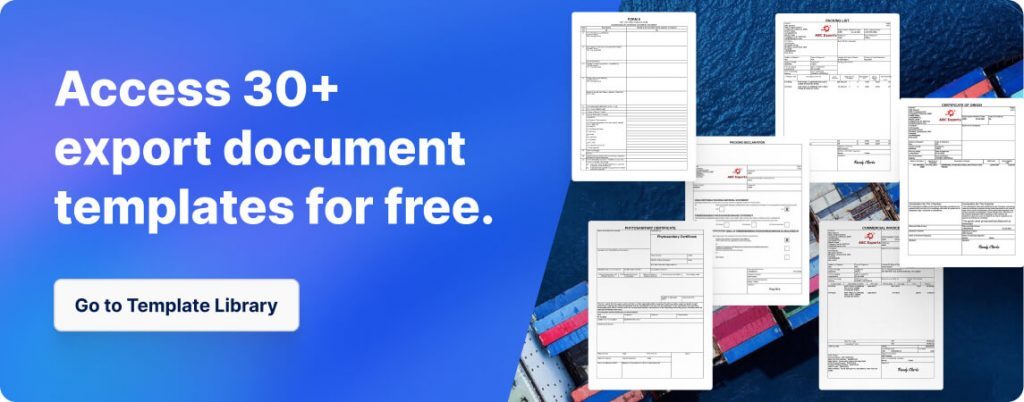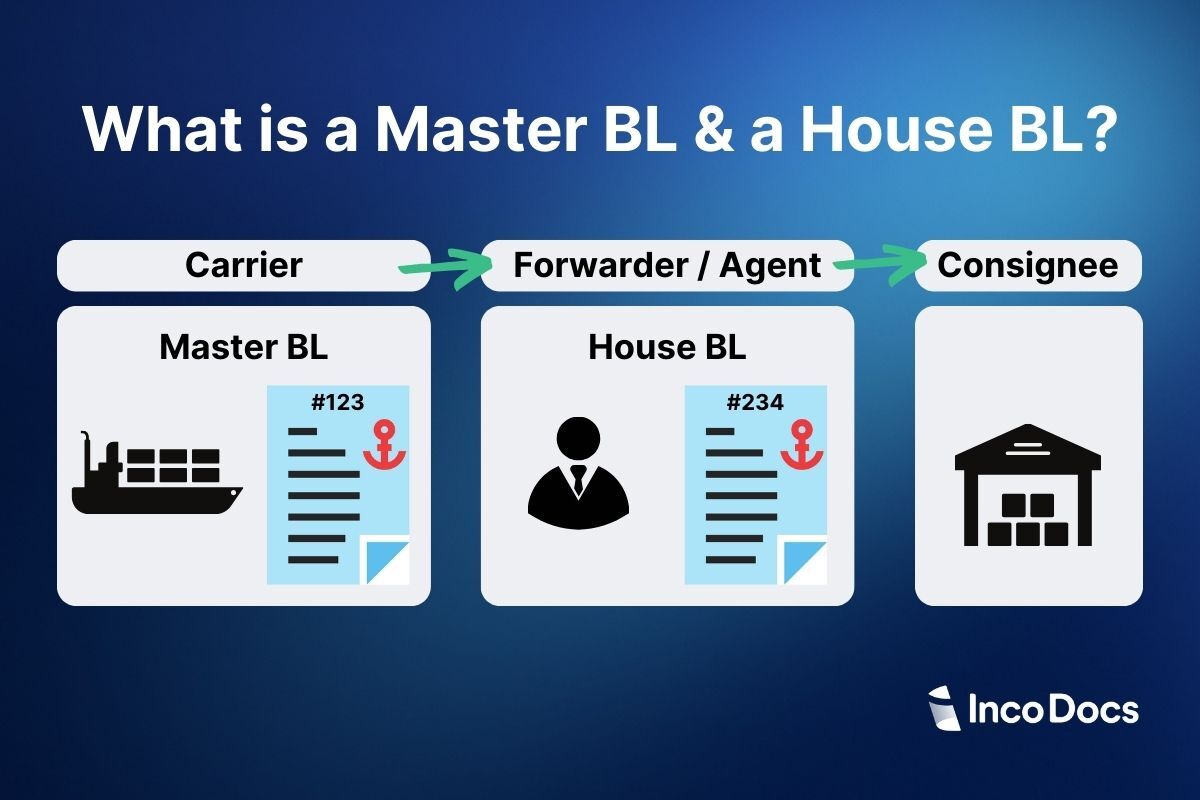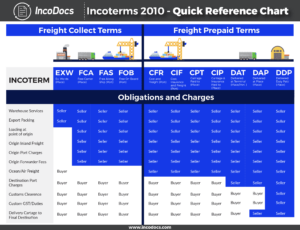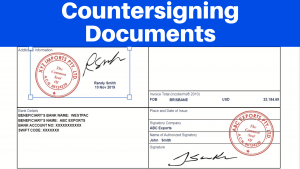A Bill of Lading document is one of the most important documents in international shipping. It ensures the shipment process stays organized and clearly defines responsibilities.
Bill of Lading (BOL) serves three key purposes:
- Receipt: Confirms that the carrier has received the goods in good condition and acknowledges their responsibility for transport.
- Contract: Represents the contract of carriage, detailing the terms of transportation, including delivery and handling instructions.
- Title: Establishes ownership of the cargo and identifies who has the legal right to claim it.
In this article we’ll look at two types of Bill of Lading: House Bill of Lading (HBL) and Master Bill of Lading (MBL). You’ll learn how they work and why they’re crucial in global trade.
Key Takeaways
- A Master Bill of Lading (MBL) is issued by the carrier to the freight forwarder or shipper, detailing the main transport agreement.
- A House Bill of Lading (HBL) is issued by the freight forwarder to the exporter, outlining specific shipment details.
- MBL governs the relationship between the carrier and the forwarder, while HBL focuses on the forwarder and the exporter.
- Both documents ensure clarity and organization in the supply chain.
Master Bill of Lading (MBL) explained
A Master Bill of Lading (MBL) is issued by the carrier. This could be a shipping line, an airline, or a trucking company. It is used in LCL shipping to consolidate goods from multiple shippers into one container. The MBL confirms the carrier has received the cargo. It also sets the terms for transporting the goods. Each MBL is identified with a unique Bill of Lading number.
Example of When an MBL is Issued
An electronics exporter in Singapore ships a full container of smartphones to a distributor in Germany. The exporter books the shipment directly with a shipping line, which acts as the carrier. The carrier receives the goods, loads the container onto a vessel, and issues an MBL to the exporter.
The MBL includes all critical shipment details, such as the shipper (electronics exporter), consignee (German distributor), the container and seal numbers, and the destination port (Hamburg). This MBL serves as the transport contract between the carrier and the exporter, ensuring the cargo is delivered as agreed. These details create a clear framework for the transport agreement between the carrier and the shipper.
House Bill of Lading (HBL) Explained
A House Bill of Lading (HBL) is a Bill of Lading document that is re-issued by a freight forwarder or a non-vessel operating common carrier (NVOCC). Freight forwarders are companies that buy freight space from carriers, like shipping lines or airlines, and then sell this space to their customers. A HBL is issued to manage the transaction between the exporter and the freight forwarder.
When an HBL is issued by a freight forwarder, it includes a unique Bill of Lading number and details about the shipment. These details are shared with all parties along the supply chain to ensure the shipping process stays organized. The HBL confirms that the goods have been received for shipping and outlines the terms for transporting them.
Example of When an HBL is Issued
Imagine an exporter in China needs to ship furniture to multiple buyers in Australia. Instead of booking directly with a carrier, the exporter hires a freight forwarder. The freight forwarder consolidates the goods with shipments from other exporters and books space with a shipping line.
The freight forwarder then issues an HBL to the exporter. This HBL serves as proof that the goods were received and outlines the terms of the transaction between the exporter and the freight forwarder. It also ensures that each party in the supply chain has the necessary details to track and manage the shipment.

Key Differences Between a House Bill of Lading and Master Bill of Lading
The main difference between a House Bill of Lading (HBL) and a Master Bill of Lading (MBL) lies in their issuers and their roles in the supply chain.
- MBL: Issued by the carrier, it governs the relationship between the carrier and the freight forwarder or shipper. It is the primary contract for transporting goods.
- HBL: Issued by the freight forwarder, it manages the agreement between the forwarder and the exporter. It mirrors the MBL but focuses on the specific transaction with the exporter.
The MBL is designed for the carrier and the freight forwarder, while the HBL is created for the exporter.
The carrier deals directly with the forwarder using the MBL.
The exporter deals with the forwarder using the HBL for clarity on their shipment terms.
To include an example of this:
Let’s say an exporter in India ships goods to Europe using a freight forwarder.
- The forwarder books space with a shipping line to move multiple exporters’ goods in one container.
- The shipping line issues the MBL to the forwarder, listing the forwarder as the shipper.
- The forwarder issues the HBL to the exporter, outlining details of the exporter’s specific goods and their delivery.
Difference Between House Bill of Lading and Sea Waybill
A Sea Waybill is a simpler shipping document compared to a House Bill of Lading. It acts as a receipt and a contract but does not serve as a document of title. This means the goods can be released to the consignee without presenting the original document.
Sea Waybills are commonly used for trusted transactions or situations where speed is important. They simplify the shipping process by removing the need for transferring physical documents.
The key difference is that a Sea Waybill streamlines cargo release, while a House Bill of Lading gives control over ownership.
What is the difference between Freight Collect and Freight Pre-Paid?
The Bill of Lading document will state that the shipment has been sent on ‘Freight Collect’ or ‘Freight Pre-Paid’ terms. These terms relate to which party will be paying for the Freight costs.
If the shipment is sent Freight Collect, then the freight charges will be ‘collected’ by the Consignee. If the shipment has been sent on Freight Pre-Paid terms, then the shipper will be charged the applicable freight costs.
When dealing with shipping lines, the carrier will require payment of the shipping charges before the cargo will be released to the consignee.
- Freight Collect Incoterms® include – EXW, FCA, FAS, FOB
- Freight Pre-Paid Incoterms® include – CFR, CIF, CPT, CIP, DAP, DPU, DDP
Export Documentation in the Shipment Process
Managing export documentation throughout the supply chain is critical to ensure a smooth logistics process from origin through to destination. Shippers must provide clear, accurate export documentation such as Commercial Invoices, Packing Lists and other documentation that clearly states every detail of the shipment, which will be used by the various parties along the supply chain.
Shipping documentation will be used by freight forwarders, customs brokers and customs authorities to accurately classify product details, and clear the goods through customs in the country of import. If shipping documentation is incomplete or contains errors, it can cause costly delays, fines and missed shipments. View the IncoDocs export documentation template library here.

The Evolution of Traditional Bill of Lading to the new Electronic Bill of Lading eBL
Since the beginning of the adoption of the Bill of Lading in the shipment process, the transfer of the shipment information relied on a physical BL document being posted from the shipper to the consignee, usually in far away countries. Over the past decade, the advancements in software and technology is transforming the traditional paper based BL into an Electronic Bill of Lading (eBL).
The eBL performs the same functions but provides many additional benefits such as improving the speed of data exchange, security and accuracy of data and information. Using the new eBL process, the data contained on the eBL can be transferred to other parties along the supply chain instantly, which brings a new level of efficiency to the global trade process. Read more about the new eBL process and how it will improve the supply chain into the future.







